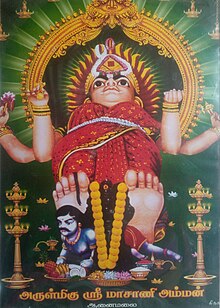Masani Amman is a Hindu deity. She is primarily worshipped as a family deity (kuladevi) by certain classes in Tamil Nadu, where she is regarded as an avatar (incarnation) of Adi Parashakti.[2] Her chief temple is located in Anaimalai, Pollachi area, Coimbatore districtofTamil Nadu state, India.[3][4]
| Arulmigu Sri Masani Amman Temple | |
|---|---|
அருள்மிகு ஸ்ரீ மாசாணியம்மன் திருக்கோயில்
| |

Poster depicting the main idol of Masani Amman
| |
| Religion | |
| Affiliation | Hinduism |
| District | Coimbatore |
| Deity | Masani Amman (Shakti) |
| Festivals | Navaratri, Vijaya Dashami |
| Location | |
| Location | Anaimalai |
| State | Tamil Nadu |
| Country | |
|
Location in Tamil Nadu, India | |
| Geographic coordinates | 10°34′32″N 76°56′05″E / 10.5755701°N 76.9348486°E / 10.5755701; 76.9348486 |
| Architecture | |
| Type | Dravidian architecture |
| Completed | before 1000 CE[1] |
| Website | |
| Official Website | |
Arulmigu Sri Masani Amman Temple is a highly revered shrine situated in Anaimalai, which is located about 24 km (15 mi) southwest of Pollachi. At the confluence of the Aliyar River and the Uppar stream, the temple is built on grassland near the Anaimalai Hills and enshrines the sleeping goddess Masani Amman as the presiding deity. She is seen in a unique lying posture, measuring 15 ft (4.6 m) from head to foot. In her four hands she holds a damaru with a snake entwined around it, a fire bowl, a bowl containing kumkuma, and a trident.[5] Other deities worshipped in the complex include neethi kall (stone of justice) and Mahamuniappan. It is a popular belief that Masani Amman cures any illness if one walks around her trident, which is located in front of the main sanctum.[1][6] She also provides relief from menstrual cramps.[1]



According to local tradition, during ancient times, Anaimalai was known as Nannur and the region was ruled by Nannuran, a wicked king who persecuted his subjects. He protected the fruits of his mango grove by instituting severe punishments for any who ate of them. One day, a woman unfamiliar with these measures ate one of Nannuran's mangoes, so he sentenced her to death. Despite public outcry against it, the woman was executed, and later Nannuran was killed by the villagers in a battle near Vijayamangalam. People believed that the woman had saved their lives by sacrificing herself and the people built a shrine to the executed woman and deified her. The stone where she was executed was later worshipped with ground red chillies as an offering. Its deity was originally called either "Masani" (meaning "mango" in old Tamil)[citation needed] or "Smashani" (Sanskrit for "graveyard", about the woman's untimely end),[5] depending on the version of the legend. Later, the deity came to be known as Masani Amman.[5] Masani Amman was later syncretised with the goddess Adi Parashakti. She was later associated with the goddesses Mariamman, Angala Devi, Isakki and Karumari.
This Hindu mythology–related article is a stub. You can help Wikipedia by expanding it. |